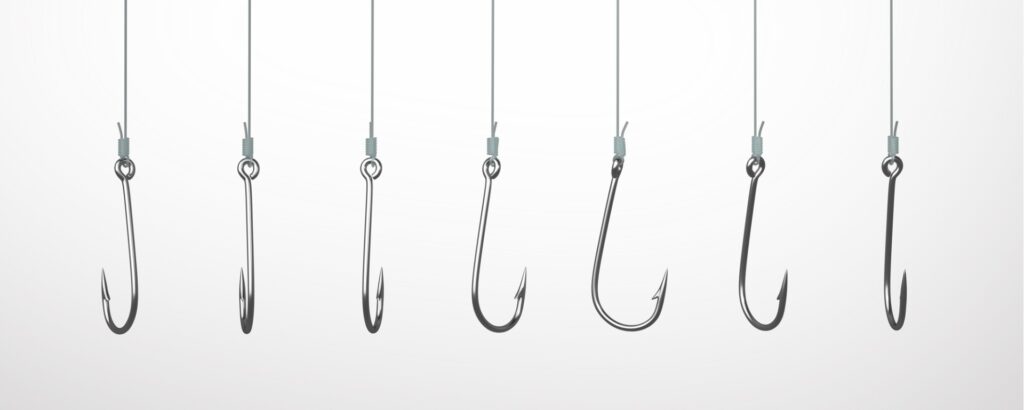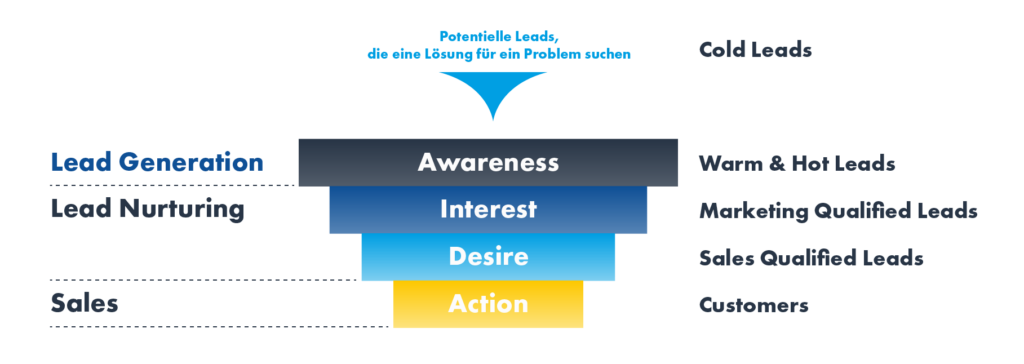Simply explained: What does lead generation mean in B2B - and why do you need it?
Share this article
Tags
Categories

Your services are in place, your product is unbeatably innovative, the website is cleverly designed, everyone is on call to advise the incoming customers and generate sales. Only - nothing happens! Where are the customers? It looks like an important aspect of the whole strategy has been forgotten: lead generation.
What is lead generation?
In the field of e-commerce and online marketing, the term "lead" refers to interested parties or customers who are at the beginning of the purchasing process. Accordingly, "lead generation" describes the way in which your company attracts prospects and converts them into buyers.
Lead generation is both part of a comprehensive marketing process and an essential component of the customer journey. The term is closely linked to that of the "marketing funnel", the sales pipeline.
The "marketing funnel" is a visualization of the steps that visitors go through to become customers - online or offline.
Salespeople have known the basic principles of this customer journey through the funnel for more than 120 years. Classically, according to the so-called AIDA formula, the funnel is divided into four phases, and it is in these phases that prospects become buyers:
- Awareness/Attention: become aware
- Interest: be interested
- Desire: developing the desire for the product
- Action: make the purchase
Lead generation takes place in the awareness phase of the funnel, the "Top of Funnel" (TOFU).
Lead generation as part of an inbound marketing strategy
Lead generation often has a negative connotation, because for many it sounds too much like "hard selling" - unpleasant, both for the customer and the salesperson. But this is no longer the case today.
Hard selling is one of the characteristics of outbound marketing. Here, potential customers are "pushed" into the funnel through aggressive and sometimes even manipulative strategies. Typical examples are the advertising tactics of the 60s and 70s - if you know the TV series "Mad Men", you know what is meant by this.
Fortunately, today's marketing landscape has changed fundamentally compared to such questionable methods, both in B2C and B2B. The two most influential trends are:
- the arrival of millennials, as digital natives, on the management floors of companies
- the rapid changes in our digital environment, the Internet and social media.
Today, potential customers have instant access to a huge amount of information about products and services - every day, everywhere, 24/7. Customers can no longer be manipulated or led around by the nose, they are too well informed for that. And they can very quickly give their displeasure with a company or product a wide reach.
This is where inbound marketing comes in. Inbound marketing focuses on attracting customers through relevant and helpful content and offers leads real added value at every stage of the funnel.
With inbound marketing, the customer's goals and needs are analyzed in detail at every stage of the customer journey. Only what serves the customer is offered. So by gaining the trust of qualified prospects, you turn them into buyers. It is a customer-centric view of revenue generation.
In contrast to outbound marketing, inbound marketing does not have to fight for the attention of potential customers, it earns it with qualitative, beneficial content.
Why is lead generation so important for e-commerce?
In e-commerce in particular, a constant influx of new customers and thus sales is vital for survival.
Only a few companies can offer a product that is absolutely unique, has no competition and therefore sells itself. For all others, however, it is important to attract the attention of potential customers and persuade them to enter the marketing funnel.
The advantages of lead generation with high-quality content are obvious:
- Increase in brand awareness
Brand awareness indicates how present you are in your target market. By generating leads, you inform potential customers about the benefits of your products. This creates trust and credibility with the target group and shows that you are an expert in your industry. It is also an opportunity to communicate your unique selling point widely and stand out from the competition.
- Addressing relevant customers
Lead generation helps you to address the right customers. Through careful and detailed customer segmentation based on demographic and psychographic aspects, you can address exactly those people who are looking for your solution. This way you avoid costly idle time. Your efforts are focused on those prospects who can be converted into customers.
- Increase in sales
A clear case. The more leads you generate, the more the marketing funnel fills up and the more you increase your sales.
What types of leads are there?
Leads are subdivided according to the phase of the marketing funnel in which they find themselves. While leads in B2C are generally private individuals, in B2B it is important to be clear about the following: although individuals are addressed, they always act on behalf of a company and therefore primarily have its goals and problems in mind.

These are the most important types of leads you should know:
- Cold Lead
This lead has not yet had any contact with your company and has therefore not yet shown any interest in your product, but fits perfectly into the profile of your ideal customer.
Your aim is to draw as many of these cold leads as possible to your attention through the appropriate channels. This allows you to separate the qualified leads from those without potential.
- Warm Lead
A warm lead is someone who has already heard of your company. These types of leads happen to follow your blogs, watch your videos or have even heard about you through word-of-mouth. Regardless of the source, these warm leads are easier to convert into potential customers than cold leads.
- Hot Lead
These are the kind of leads who have already shown interest in your product in one way or another. These leads are in the research phase for a current problem, look at a lot of things and make comparisons. The potential to acquire such leads as customers is huge. But you need to act quickly and reach customers with the right kind of information at the right time.
- Marketing-Qualified Lead
These leads are actively looking for solutions that can help them and they are interested in learning more about your solutions. This means they are already halfway through the marketing funnel and can become customers with detailed, customized information.
- Sales-Qualified Lead
Sales-qualified leads are customers who are ready to meet with your sales team. They are very interested in your offers and are ready to buy, so they just need to be guided through the sales process.
How do you successfully generate leads?
For successful lead generation, the quality of the content counts more than the quantity.
The second criterion is the correct identification of the channels, both online and offline, on which potential customers move. If, for example, the "customer segments" and "channels" have been defined using a business model canvas, these inbound channels can be assigned very precisely.
The aim of lead generation is to attract the attention of potential buyers. This customer segment is aware of a problem and is actively looking for solutions. The "audience" is at the beginning of the "buyer journey". In this phase, the lead is still interested in all possible solutions, but has not yet made a decision and simply wants to be informed precisely and comprehensively.
It is therefore important to share content that provides solutions to problems without being too direct or even sensationalist.
The following tactics have proven successful in practice to guide customers into the awareness phase of the funnel:
- Findability in a search engine like Google
- Content Marketing
- Search engine optimized articles on the website
- Pay-per-click advertising on Facebook etc.
- Online networking
- Events, webinars and other courses
- Email marketing - campaigns based on LinkedIn searches
- Podcasts
- Social Listening
- Content outreach
If you reach an interested audience using these tactics, they will often be directed to so-called "lead gen pages".
The purpose of a lead gen page is to ensure that prospects perform a certain action, also known as a "call-to-action". This usually involves "lead capture". This means that anonymous visitors become known names and enter into communication with your company. The visitors exchange personal data, usually their email address, for a "lead magnet".
In the B2B sector, these "lead magnets" are often whitepapers, checklists or e-books that address the needs of visitors, address their problems and offer solutions.
As soon as the anonymous prospects can be contacted by name, they are on the second level of the marketing funnel, in lead nurturing, and become marketing-qualified leads.
What are the challenges of lead generation for retailers?
Although the principles behind lead generation are simple and logical, there are some challenges to actually implementing them successfully. These are the most common challenges:
- Find a suitable lead generation tactic tailored to the target group.
- Establish suitable structures in your own company to be able to carry out lead generation consistently and authentically - from the strategy owner to the design of the various campaigns and the creation of suitable content.
- Establish a system that measures the success of lead generation and shows where optimization is possible.
Conclusion
The challenges are great, but if your company rises to them and builds an authentic, sustainable lead generation strategy, you will reap the rewards in the form of profitability and sales growth.
Further contributions
No contributions found.
